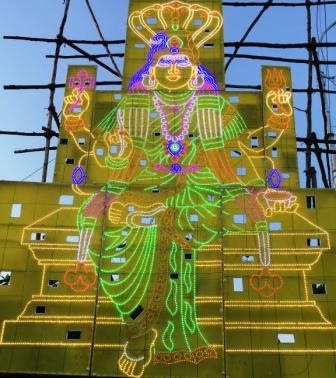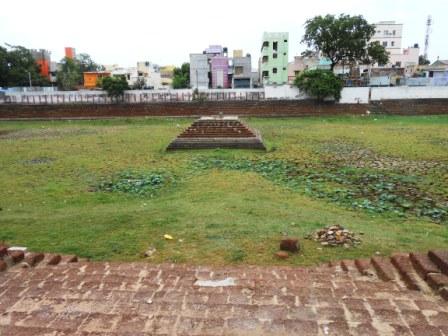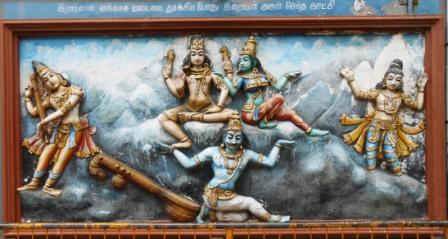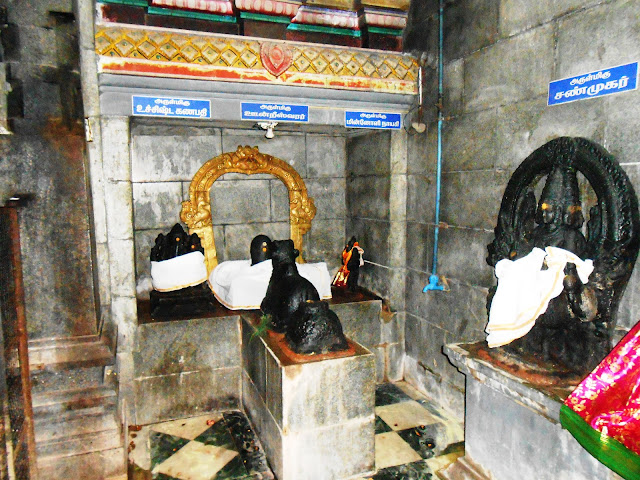17th August
2015
On
16th August, I went to the Purasaiwakkam Sri Gangadeeswarar
Temple. This visit was planned to worship Sri Oondreswarar
of Thiruvenpakkam, where Lord Shiva gave Oondrukol to Sundarar when he lost his
eyes. The original Murtis are brought to this temple while constructing the
Poondi reservoir. Lord Shiva wishes to stay here even after constructing a new temple at Thiruvenpakkam, the present Poondi.
From
Guindy to Egmore went by Train and from Egmore Railway
station walked up to the temple. The route was Egmore Railway station –
Poonamallee High Road- Dr. Alagappa Chettiar Road – Sri Gangadeeswarar Temple
Road.
SRI
PANGAJAMBAL SAMEDHA SRI GANGADEESWARAR TEMPLE – PURASAWALKAM.
This
temple is at Purasawalkam, a part of Chennai City close to Egmore.
Moolavar : Sri Gangadeeswarar
Consort : Sri Pangajambal
Some
of the important features of this temple are...
The
temple faces east with a 5-tier Rajagopuram. Dwajasthambam, Balipeedam, and Rishabam are on the front side.
In
the outer praharam Urchavar Mandapam with 63var, Siddhi
Vinayagar, Vaitheeswarar, Sri Balasubramaniar, Kuruntha Malleeswarar (North
Indians do abhishekam on their own hands), Ambal Temple Simha vahana with balipeedam and Dwajasthambam, Sathya Narayana Perumal, Bana Lingam
without avudayar, Yaha salai, Navagrahas, and Sri Ramalinga Vallalar.
In
the outer praharam walls stucco bas-reliefs of Shiva’s Leela. They are Shiva’s Anandha thandavam, Carried mud to stop the water of Vaigai for Pittu, Shiva
kicking Yama for Markandeyar, Kannappar applying his eyes of Shiva,
Burning Muppuram / Tripurantaka, Ravana lifting Kailash, Shiva gave darshan to Karaikal Ammaiyar.
The
sthala purana stucco images are Bhakirathan not respecting Narathar
and Narathar giving curse/sabam, Bhagirathan worshiping Lord Shiva, and Lord Shiva giving
darshan to Bhagirathan.
The temple sthala purana - Bhakirathan’s court where Ladies are dancing and Narathar was respected when he visited Bhakirathan’s court. Narathar gave him sabam to get the decease of mega noi. (மேக நோய் )
The temple sthala purana - Bhakirathan Worshiping Lord Shiva – Ganga flowed from Shiva’s head and Bhagirathan got relieved from the decease. (In another version, Bhakirathan got Ganga water to get rid of his ancestor's sin.)
In
the inner praharam sannadhi for Ambal, Naalvar, Maha Ganapathy, Nagars,
Bhagirathan, Kasi Viswanathar, Sekkizhar, Kulachirai Nayanar, Suryan, Sri Valli Devasena Subramaniar, Uchishta Ganapathy, Sri Oondreswarar, Minnoli ammai,
Shanmugar, Durgai, Bhairavar, Dakshinamurthy, Palliyarai, Bhairavar,
Chandran, Suryan, Natarajar Saba.
Nalvar
Reliefs is on the pillar in front of Moolavar sannidhi. Once, this place was with a large number of Purasu trees, hence, this place was called Purasawalkam
Around the Sanctum
is in the form of a moat/ agazhi type. In koshtam Vinayagar, Dakshinamurthy, Maha Vishnu,
Brahma and Durgai.
HISTORY AND INSCRIPTIONS
As per the inscriptions, this place was in Puliyur Nadu, a sub-division in Jayangonda Chozha mandalam during the Chozha period. (Ref: Chennai Mavatta Kalvettukal, Tamil Nadu, Archaeological Department)
The 13th-century inscription records the endowment of burning a lamp at Jayangonda Chozhamandalathu Puliyur Nattu Thiruvanmiyur Ulakaludaya Nayanar Temple by Neelakangaraiyan.
The 15th Century Vijayanagara period inscription (maybe Devarayar), is found much damaged. the letters like kanda kanda, Samudrathi, Kesavettai, Sri Veeraprathapa, Raya maha rayar etc. The details couldn't be identified.
The 16th-century Vijayanagara period inscription records the endowment of burning a lamp daily for the same Kong.... kon Azhagu Perumal, one of the mandradis kudi amarthappattathu (may be given to this temple), belongs to Jayangonda Chozha mandalam.
Another 16th-century Vijayanagara period inscription is much damaged, and words like taxes and Kanikkai are mentioned.
LEGENDS
Legends like Tripura Samharam, Ravana Lifting Mount Kailash, Vinayagar get Gnana Pazham, and Bakiratha's penance to bring the Ganga river are in the form of stucco images on the wall.
Stucco relief of Shiva’s Leela – burning of Muppuram
Sudhai relief of Shiva’s Leela – Churning the Par Kadal – Vasuki the snake – as thread and Mount Meru as Mathu (மத்து).
The story of Gnana pazham (ஞான பழம் )
Stucco image of Shiva’s Leela-Ravana Lifting Kailash
POOJA TIMINGS:
The
temple is kept open for darshan between 07.00 hrs to 11.00 hrs and 16.30 hrs
to 21.00 hrs
CONTACT DETAILS :
The
office telephone number is 044 26422487
The
temple website is
HOW TO REACH :
Bus
facilities are available from various parts of the city.
2 km from Egmore station via Gandhi Irvin Road – Nair Road – Dr. Alagappa Chettiar
Road – Gangadeeswarar temple road.
This temple is at Villivakkam, a part of Chennai
City and close to the Bus terminus and Railway station. This
temple is believed to be one of the Thevara Vaippu Sthalam sung by Thirunavukkarasu Swamigal.
நாடகமா டிடநந்தி கேச்சுரமா
காளேச்
சுரநாகேச் சுரநாக
ளேச்சுரநன் கான
கோடீச் சுரங் கொண்டீச்
சுரந்திண் டீச்
சுரங்
குக்குடேச் சுரமகத்தீச்
சுரங்கூறுங்கால்
ஆடகேச் சுரமகத்தீச் சுரமய
னீச்சுர
மத்தீக்சுரஞ் சித்தீக்சுர
மந்தண் கானல்
ஈடுதிரை யிராமேசசுர மென்றென்
றேத்தி
யிறைவனுறை சுரம்பலவு
மியம்பு வோமே.
….. திருநாவுக்கரசு சுவாமிகள் ( 6-71-8 )
Moolavar Gajabirusta Vimanam
Moolavar : Sri Agastheeswarar
Consort : Sri Swarnambika
Some of the important features of this temple
are...
The main entrance is from the south with a Mottai
Rajagopuram, and the arch above was built in recent years.
Dwajasthambam, balipeedam, and Rishabam are at the
east entrance in the outer praharam. Sannadhi for Naagars, Lingas, Vilvambigai, Aadhi
Sankara, and Navagrahas.
In the inner praharam Surayan,
Nandeeswarar (with Rishabam head), Naalvar, Ganapathy, Urchavars, Kasi
Viswanathar, Agasthiyar, Palani Andavar, Lakshmi, Saraswathy, Sri Valli
Devasena Subramaniar, Chandikeswarar, Bairavar, and Chandran.
Vinayagar and Subramaniar are at the entrance of
sanctum. Dwarapalakas are a little big and cute.
In koshtam Vinayagar, Dakshinamurthy, Vishnu,
Brahma, and Durgai. Sanctum is of the Gajabrushta type and Agazhi type of
construction. Moolavar is in an elevated position. Nagabharanam
looks cute.
Ambal sannadhi is in the same prakaram facing
south. Lord Shiva permitted Ambal to give darshan to Agasthiyar with
gold ornaments, hence, Ambal is called Sri Swarnambika. This
sthalam is one of the 108 Sakthi sthalam.
HISTORY AND INSCRIPTIONS
The temple has Chozha Period inscriptions which prove
that the temple existed for more than 500 years. (A separate post is
written about the inscriptions).
The stones with inscription (only a portion of the epigraph) on the wall in the inner praharam. Could not identify, in which language it was written. With a little light, I found that the stone was kept upside down. Some inscription blocks are used for the outside wall. We cannot trace under whose period the temple was constructed. It was a mesh. There are some inscriptions on the base of the Ambal sanctum also in an unreadable condition.
Epigraph details are not mentioned in the temple website either. In the name of renovation, without knowing the importance of the epigraph details the identity and authenticity of the temple was destroyed, and the future generations will be kept in the dark. Here are some of the epigraphs/inscriptions.
This epigraphic stone is kept upside down.
The epigraph on the base of the Ambal sanctum base
The epigraph on the base of the Ambal sanctum base
This epigraph is on the outside wall
LEGENDS
History says that Agasthiyar killed the demons Vilvalan and Vatapi. To get rid of brahmahathi dosam, Sri Veerabhadra helped Agasthiyar and got relieved. Hence, Sri Veerabhadra's sannadhi is opposite the South side entrance and facing north.
Mars created a spring and worshiped Lord Shiva. Naagars are around Neem and Peepal trees on a raised platform. Devotees worship during the Aadi Tamil month.
TEMPLE
TIMINGS :
The temple is kept open between 06.00 hrs to 12.00
hrs and 16.00 hrs to 20.30 hrs with 4 Kala poojas.
CONTACT
DETAILS :
The telephone number is 044 26172326
TNHRCE Dept Executive officer 9790996743 &
Clerk 9952038155
Temple web site
HOW
TO REACH :
Villivakkam is well connected with various parts
of Chennai city and a km from Bus terminus and Railway station.






























